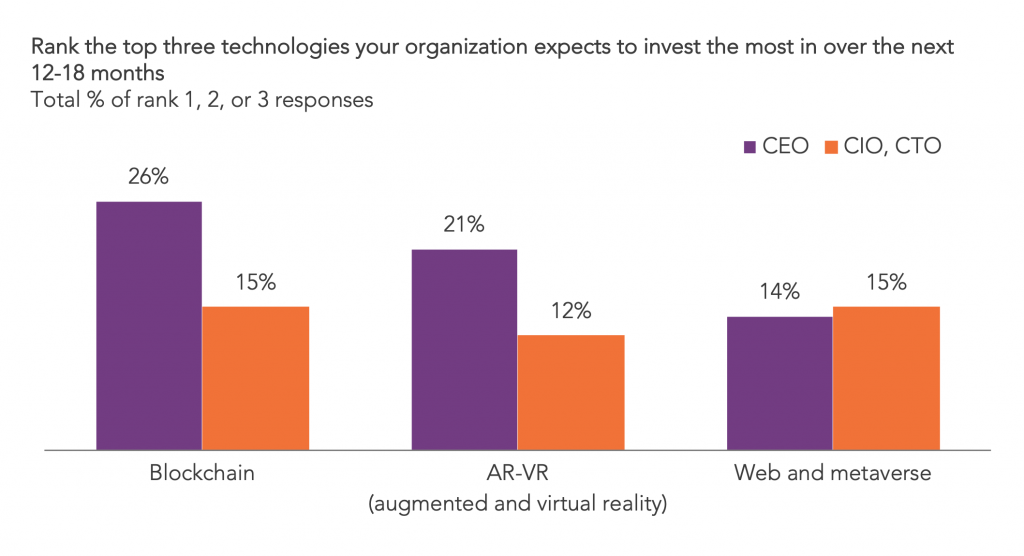Metaverse enthusiasts must prove the metaverse is much more than a vanity project if they wish to avoid being relegated to the list of discretionary projects indefinitely postponed by recession-wary CFOs.
If 2022 was the year of building capability, with several service providers offering their clients a buffet table filled with “free lunch” metaverse experiments, then 2023 will be a year to convert these expectations into fulfillment.
Our regular interactions with leading service providers tell us budgets are switching from investments in which accepting a “return on learning” is acceptable to demand at least some yield. We expect enterprise spending to move from the innovation pot to business unit spending, too. Our data in Exhibit 1 shows the intended investment in metaverse and Web 3 technologies by the CIO and CTO departments has edged ahead of the ambitions of the CEO, who is prioritizing blockchain and AR-VR (augmented reality and virtual reality) spending. As belts tighten, it will take rapid traction to sustain spending.
With that said, HFS values total spending on metaverse-related tech and services in the region of $50 billion in 2022, with global market revenues having the potential to surpass 10 times this number by the end of the decade. We don’t expect to see massive revenues overnight. Rather, we are on a five-to-10-year timeline where serious monetization of the metaverse is concerned. Still, investments already being made, or planned, in resources, teams, and testing are likely to be scaled back if they don’t gain traction by mid-year.

Sample: HFS Pulse 2022, n=98 Global 2000 CEOs, 104 Global 2000 CIOs and CTOs
Source: HFS Research, 2023
The fastest routes to the extraction of value from metaverse spend in 2023 will be:
We expect all the above to come out of the innovation lab and into enterprise scale, with service providers offering them as implementable elements integrated with their core offerings.
The VR and AR strands of the metaverse should be embedded in any employee experience product, service, or program. Given the changing needs of our widely distributed workforces and the scalability of collaboration and knowledge-sharing that immersive technologies can support, it is unwise to offer metaverse EX services as optional bolt-ons. AR and VR technologies already contribute more than a third of metaverse spending.
If your concern about take-up is the need for cumbersome headsets to engage in training in virtual environments, for example, stand by for Apple Glasses. Apple has a headset on the way, but its lightweight glasses, due to follow one to three years behind, promise to be game-changing. They should provide an upgrade to Google’s failed glasses project, with the processing power held in your accompanying iPhone. A range of alternative‘ glasses’ offerings were also lined up at tech show CES in January 2023.
To deliver customer experience strategies, products, and services without an integrated metaverse play would be like putting together a marketing plan in 2010 and leaving out social media. There are already at least 400 million active monthly metaverse users. With as many as three-quarters of US adults considering joining in, we expect that number to increase quickly. Social media took three years (2009–2011) to grow from 400 million to 1 billion users. With the viral spread made possible by the scale of today’s social media (ChatGPT reached 1 million users in a week in December 2022, for example), we expect the metaverse to hit the magic 1 billion point by the end of 2023.
The immersive 3D environment of the metaverse offers opportunities for the best-yet visualization of data. Digital twin modeling of everything from warehouses to supermarket planning layouts to supply chains and new product design and development places digital twins at the heart of a $180 billion metaverse opportunity for manufacturing alone. Think of the metaverse as our best-yet 3D data visualization tool, unlocking a (real and virtual) world of new use cases. It follows the model of the HFS OneOffice Data Cycle in Exhibit 2, in which delivering data to the right people at the right time—and in the best possible format for decision-making—is crucial.
Digital twins have long been part of most service providers’ data and analytics armory. To this extent, they are already further developed as part of integrated solutions, providing an example for solution leaders in customer experience and employee experience to learn from and repeat.
The advantage the rise of the metaverse has over previous paradigm shifts is it arrives in an era in which rapid iterative product discipline is endemic. Executives now expect their service vendors to help them through a value-led approach to new product and service development, building on principles drawn from Agile, design thinking, and Lean start-ups (among others). The age of “if we build it, they will come” is over.
Therefore, we expect service providers who succeed in scaling their metaverse solutions to come to their enterprise customers with frameworks to identify and evaluate the value opportunity, providing the confidence for scaled investment. For traction, these will need to focus on rapid functional and tactical value. Where this succeeds, service providers will have earned themselves the right to support enterprise-wide and cross-ecosystem metaverse strategies.

Source: HFS Research, 2023
From the point of view of enterprise spending, the metaverse is in a precarious place as we enter 2023. No one expects it to explode into crazy revenues just yet, but it must start earning its keep, or budgets will tumble—with a knock-on impact on the provision of supporting services. CIOs must look to their service providers to bring the rigor of value frameworks to the metaverse party. It’s time to get serious.
Still struggling to wrap your head around the metaverse opportunity? Start here:
Coming soon: HFS’ first-ever metaverse services Horizons report.
Register now for immediate access of HFS' research, data and forward looking trends.
Get StartedIf you don't have an account, Register here |
Register now for immediate access of HFS' research, data and forward looking trends.
Get Started